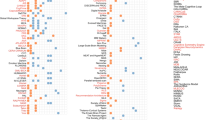Abstract
When trying to gain intuitions about the computations implemented in neural circuits, we often use comparisons with electronic circuits. However, one fundamental difference to hard-wired electronic circuits is that the structure of neural circuits undergoes constant remodeling. Here, we discuss recent findings highlighting the dynamic nature of neural circuits and the underlying mechanisms. The dynamics of neural circuits follows rules that explain steady state statistics of synaptic properties observed at a single time point. Interestingly, these rules allow the prediction of future network states and extend the insights gained from serial sectioning electron microscopy of brain samples, which inherently provides information from only a single time point. We argue how the connectome’s dynamic nature can be reconciled with stable functioning and long-term memory storage and how it may even benefit learning.






Similar content being viewed by others
References
Bliss TV, Lomo T (1973) Long-lasting potentiation of synaptic transmission in the dentate area of the anaesthetized rabbit following stimulation of the perforant path. J Physiol 232(2):331–356
Feng G, Mellor RH, Bernstein M, Keller-Peck C, Nguyen QT, Wallace M, Nerbonne JM, Lichtman JW, Sanes JR (2000) Imaging neuronal subsets in transgenic mice expressing multiple spectral variants of GFP. Neuron 28:41–51
Loewenstein Y, Kuras A, Rumpel S (2011) Multiplicative dynamics underlie the emergence of the log-normal distribution of spine sizes in the neocortex in vivo. J Neurosci 31(26):9481–9488
Loewenstein Y, Yanover U, Rumpel S (2015) Predicting the dynamics of network connectivity in the neocortex. J Neurosci 35(36):12535–12544
Miner D, Triesch J (2016) Plasticity-driven self-organization under topological constraints accounts for non-random features of cortical synaptic wiring. Plos Comput Biol 12(2):e1004759
Moczulska KE, Tinter-Thiede J, Peter M, Ushakova L, Wernle T, Bathellier B, Rumpel S (2013) Dynamics of dendritic spines in the mouse auditory cortex during memory formation and memory recall. Proc Natl Acad Sci USA 110(45):18315–18320
Perin R, Berger TK, Markram H (2011) A synaptic organizing principle for cortical neuronal groups. Proc Natl Acad Sci 108(13):5419–5424
Song S, Sjöström PJ, Reigl M, Nelson S, Chklovskii DB (2005) Highly nonrandom features of synaptic connectivity in local cortical circuits. PLoS Biol 3(3):e68
Statman A, Kaufman M, Minerbi A, Ziv NE, Brenner N (2014) Synaptic size dynamics as an effectively stochastic process. Plos Comput Biol 10(10):e1003846
Stepanyants A, Chklovskii DB (2005) Neurogeometry and potential synaptic connectivity. Trends Neurosci 28(7):387–394
Takeuchi T, Duszkiewicz AJ, Morris RG (2013) The synaptic plasticity and memory hypothesis: Encoding, storage and persistence. Philos Trans R Soc Lond B Biol Sci 369(1633):20130288
Yang G, Pan F, Gan WB (2009) Stably maintained dendritic spines are associated with lifelong memories. Nature 462(7275):920–924
Yasumatsu N, Matsuzaki M, Miyazaki T, Noguchi J, Kasai H (2008) Principles of long-term dynamics of dendritic spines. J Neurosci 28(50):13592–13608
Zheng P, Dimitrakakis C, Triesch J (2013) Network self-organization explains the statistics and dynamics of synaptic connection strengths in cortex. Plos Comput Biol 9(1):e1002848
Funding
Jochen Triesch is supported by the Quandt foundation.
Author information
Authors and Affiliations
Corresponding authors
Ethics declarations
Conflict of interest
S. Rumpel and J. Triesch state that they have no competing interests.
This article does not contain any studies with human participants or animals performed by any of the authors.
Rights and permissions
About this article
Cite this article
Rumpel, S., Triesch, J. The dynamic connectome. e-Neuroforum 7, 48–53 (2016). https://doi.org/10.1007/s13295-016-0026-2
Published:
Issue Date:
DOI: https://doi.org/10.1007/s13295-016-0026-2




